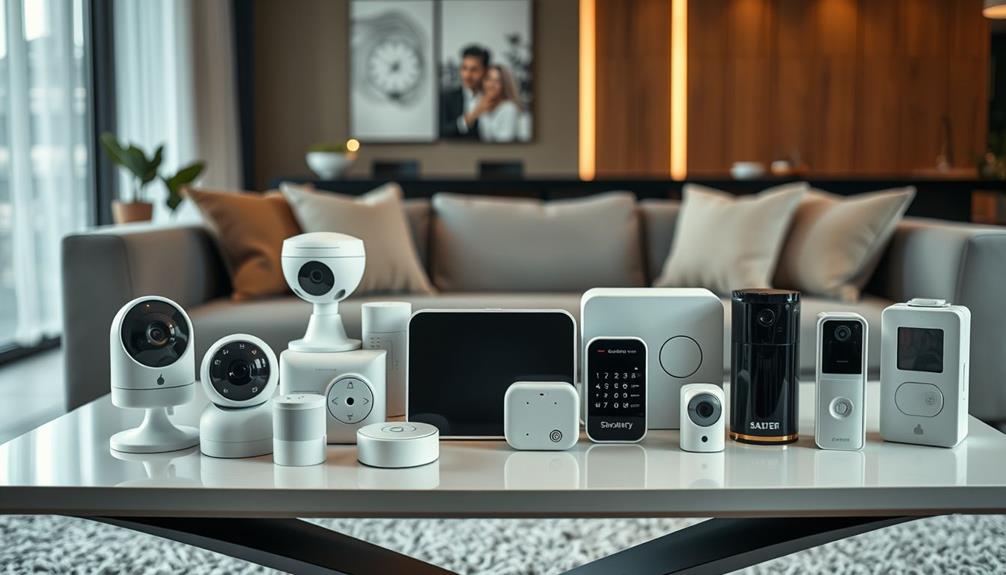There are many home security systems available to meet your specific needs. You can choose from monitored systems with 24/7 professional oversight or go for unmonitored systems that you manage yourself. Wireless options make installation easy, while DIY kits let you set things up without contracts. Video surveillance and smart home integration are also popular choices. With around 72% of U.S. households using at least one security device, you're certainly not alone in wanting to protect your home. If you're curious about the different types and features available, you'll find some fascinating insights ahead.
Key Takeaways
- The global home security market is projected to reach $84.4 billion by 2027, indicating a vast number of systems available.
- Approximately 39 million U.S. households currently utilize alarm systems, showcasing widespread adoption of home security solutions.
- Home security systems are categorized into monitored and unmonitored systems, each with various features and options.
- There are diverse types of systems including wired, wireless, DIY, and hybrid systems, catering to different homeowner needs.
Home Security Market Overview
The global home security market is booming, projected to reach $84.4 billion by 2027, thanks to a growing demand for safety and protection among homeowners.
With around 39 million U.S. households currently relying on alarm systems, it's clear that many of you recognize the importance of safeguarding your properties. Homes without security systems face a staggering three times the risk of burglaries, which further emphasizes the necessity of effective security measures.
Younger adults, particularly those aged 18-29, are driving this trend, showcasing a heightened awareness of security. Many of you're opting for advanced security technology, which includes smart home features that offer convenience and peace of mind.
The median initial cost for home security systems, including installation, is about $300, and the average monthly monitoring fee is only $10. This makes investing in security systems more accessible than ever.
Additionally, with options for DIY installation, setting up your home security has never been easier. The global home security market is evolving rapidly, blending traditional alarm systems with innovative technology to cater to the diverse needs of homeowners.
Types of Home Security Systems

Understanding the different types of home security systems can help you choose the right one for your needs and budget. You'll find two main categories: monitored systems and unmonitored systems.
Monitored systems offer 24/7 professional monitoring, giving you peace of mind, while unmonitored systems allow you to handle your own security without oversight. Additionally, modern security systems often enhance home security with garage door openers that incorporate smart technology for added protection.
Wireless security systems are popular due to their easy installation process and minimal invasiveness. If you prefer a hands-on approach, DIY security systems let you install and manage your system without long-term contracts.
For those seeking flexibility, hybrid systems combine both wired and wireless components, offering customized security solutions based on your home's layout.
Additionally, smart home integration has revolutionized security, allowing you to connect IoT devices for enhanced protection. This integration not only improves your security measures but also makes management more convenient.
Ownership Statistics

Around 72% of U.S. households have at least one home security device, showing just how essential these systems have become in everyday life. The rise in ownership statistics reveals a strong commitment to safety and security in our communities.
Here are some remarkable figures:
- 39 million households are equipped with alarm systems, representing a significant market presence.
- Approximately 51 million homes have video surveillance systems, reflecting the growing trend in security technology.
- About 37% of homes utilize video doorbells, indicating a shift towards smart home integrations.
- Nearly 900,000 burglaries occur annually in the U.S., emphasizing the importance of effective home security systems.
This data underscores the critical role of security devices in preventing crime and enhancing peace of mind.
As technology continues to evolve, more households are likely to invest in advanced alarm systems and video surveillance, integrating these features into their daily lives.
Effectiveness of Security Systems

Security systems considerably reduce the likelihood of burglaries, making homes much safer for you and your family. Research shows that homes equipped with security measures are 300% less likely to experience break-ins compared to those without.
Alarm systems play a critical role in this effectiveness; 83% of burglars assess for alarms before attempting a break-in, and 60% avoid homes with visible security systems. The psychological impact of these security measures can't be underestimated. In fact, 50% of burglars abandon their attempts upon discovering an alarm is present.
Furthermore, a Rutgers study highlights a significant reduction in property crime rates linked to the installation of alarm systems. Surveillance also enhances safety—over 96% of individuals feel more secure in neighborhoods with security cameras.
As a homeowner, investing in effective security systems not only protects your property but also contributes to a broader sense of community safety. In conclusion, the effectiveness of security systems in deterring crime is clear, making them an essential consideration for enhancing your home's safety.
Costs of Home Security Systems

Investing in a home security system involves various costs, from installation to ongoing monitoring fees, that homeowners should carefully consider. Here's a breakdown of the typical expenses you might encounter:
- Installation Cost: Ranges from $200 to $1,200, with an average around $475.
- Monthly Fees: Professional monitoring services average about $32, with plans as low as $8 and others exceeding $60.
- Starter Kits: Basic kits are priced around $460, while prebuilt packages can start as low as $139.99.
- Advanced Systems: These can exceed $1,000, depending on included features and equipment.
When selecting a home security system, weigh the installation cost against potential monthly fees and consider the benefits of insurance discounts.
Whether you opt for a starter kit or an advanced system, understanding these costs will help you make an informed decision.
Future Trends in Home Security

As you look ahead to the future of home security, you'll notice exciting advancements in AI integration and biometric features.
These technologies promise to enhance your security experience by improving threat detection and personalizing access control.
With these innovations, your home won't only be safer but also smarter.
AI Integration Advancements
With the rise of artificial intelligence, home security systems are becoming smarter and more responsive, greatly enhancing their ability to detect and respond to threats in real time. You can expect the following advancements in AI integration for home security:
- Enhanced threat detection: AI systems analyze data to identify potential security risks swiftly.
- Real-time analysis: These systems respond instantly to unusual activities, ensuring a quicker reaction to threats.
- Voice recognition technology: Control your security setup and receive alerts using simple voice commands, making it more user-friendly.
- Predictive analytics: AI predicts security risks by examining historical data, allowing you to take proactive measures.
This AI integration not only increases the effectiveness of home security systems but also reduces false alarms by learning your household's unique patterns.
As technology progresses, these capabilities will further enhance your home's safety, making it easier to stay informed and protected against potential threats.
Biometric Security Features
Integrating biometric security features into home systems is revolutionizing how you authenticate and control access, offering a level of security that's both unique and hard to bypass. These features, like facial recognition and fingerprint access, enhance user authentication and provide robust access control. Since each individual's biometric data is unique, it's challenging for intruders to replicate or bypass these systems.
As smart home technologies evolve, the integration of biometric sensors is expected to become more prevalent. This seamless integration with existing security devices means you can easily upgrade your home security without overhauling your entire system.
A recent survey shows that consumer preferences are shifting toward these advanced measures, indicating a growing acceptance of biometric technology in home security.
This rising demand for biometric security features is driving innovation within the market, aligning with the trend of prioritizing user experience and personalized security solutions. By adopting these cutting-edge technologies, you can enhance your home's security and gain peace of mind, knowing that your access control measures aren't only sophisticated but also tailored to your unique needs.
Frequently Asked Questions
How Many Home Security Systems Are There in the Us?
You'll find that approximately 39 million U.S. households have alarm systems installed, with 72% of homes featuring at least one security device. This reflects a growing commitment to home protection among consumers like you. In recent years, the demand for home security systems in America has steadily increased as people become more concerned about safeguarding their families and property. Advancements in technology have made these systems more accessible, customizable, and user-friendly, allowing homeowners to monitor their homes remotely at any time. As a result, home security has transitioned from being a luxury to an essential household feature for many.
What Is #1 Security System?
If you're looking for the best security system, Vivint's your top choice. With advanced features, professional monitoring, and easy smartphone control, it guarantees your home stays safe and secure, all starting at just $29.99 per month.
How Many Types of Alarm Systems Are There?
When you're exploring alarm systems, you'll find three primary types: monitored, unmonitored, and hybrid. Each offers distinct advantages, from professional oversight to budget-friendly options, ensuring you can choose what best fits your needs.
What Percentage of Homes Have a Security System?
About 35% of U.S. households have security systems installed. This trend shows a growing awareness of safety, with many people prioritizing protection for their homes, especially as burglaries are considerably more likely without these measures.
Conclusion
To sum up, the home security market is booming with over 1,300 different systems available today, making it easier than ever for you to find the perfect fit for your needs.
Did you know that homes without security systems are 300% more likely to be broken into?
With the right system, you can't only protect your home but also gain peace of mind.
As technology continues to evolve, your options will only get better, so stay informed!









